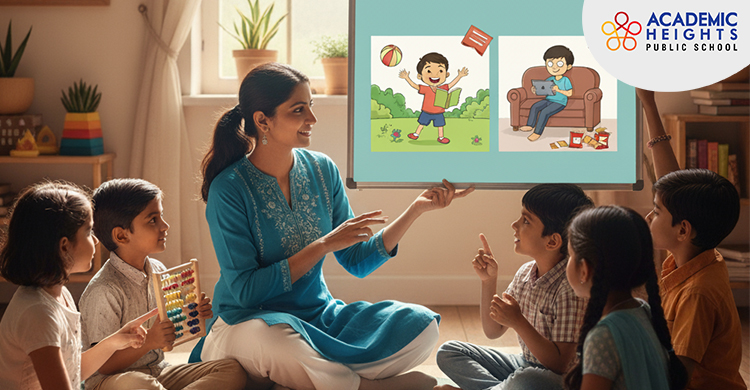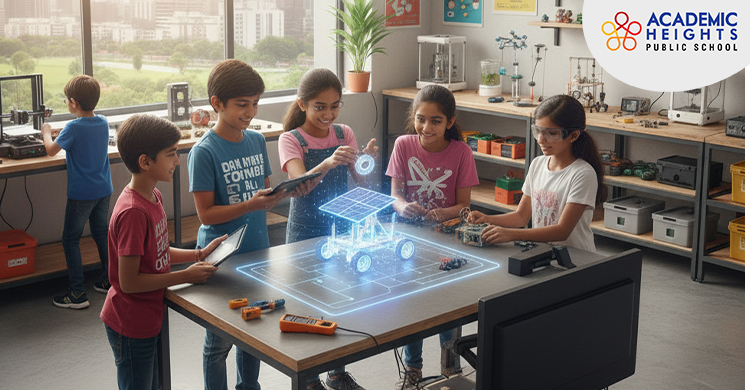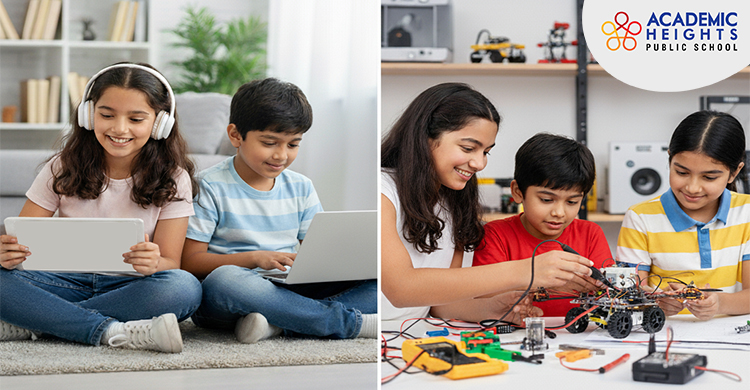Balancing screen time has emerged as one of the main issues students face in today’s digital era. Although technology presents numerous learning opportunities, overuse can impair concentration and creativity. By fusing technology with practical experiments, integrating fruitful STEM activities with screen time ensures that students participate in meaningful ways. Parents and teachers can help students benefit from technology while encouraging curiosity, creativity, and real-world skills. That goes beyond the screen by carefully controlling their children’s digital exposure.
Why Balancing Screen Time Matters for Children?

It’s important to balance screen time because too much digital exposure can impair children’s ability to concentrate, sleep, and interact with others. Even though technology presents educational opportunities, excessive screen time can stifle creativity and experiential learning. Children can explore STEM topics, participate in meaningful activities. This also helps them hone their critical thinking abilities by controlling their screen time. Maintaining this equilibrium promotes curiosity, healthy development, and fruitful learning both online and offline.
Productive STEM Learning: Beyond Passive Screen Use

STEM learning promotes practical experiments, problem-solving, and critical thinking, going beyond passive screen time. Students who actively engage with concepts turn technology from a diversion into a potent instrument for creativity and real-world comprehension.
1. Encouraging Hands-On STEM Activities: Students who participate in hands-on activities instead of passive screen time are more likely to learn STEM subjects effectively. They gain a deep understanding of STEM, sharpen their problem-solving abilities, and ignite their creativity through building, experimenting, and exploring real-life concepts. This makes learning enjoyable and fulfilling.
2. Fostering Problem-Solving Skills Through STEM: By promoting problem-solving abilities through STEM education, students can develop their critical thinking and creative problem-solving abilities. By working on practical projects and experiments, they rise above passive screen time. This enhances their analytical thinking and self-assurance in real-world situations.
3. Using Technology as a Tool, Not Just Entertainment: STEM education transforms technology from a source of entertainment to a useful tool. Students can experiment, explore ideas, and solve problems by carefully utilising apps, simulations, and interactive projects. This makes screen time meaningful and develops curiosity, creativity, and practical skills that go beyond simple consumption.
4. Connecting STEM to Real-World Applications: When students relate concepts to practical uses, STEM education becomes genuinely effective. They can observe how science, technology, engineering, and math affect daily life through practical projects, experiments, and problem-solving exercises. This makes learning interesting, relevant, and meaningful outside of the screen.
5. Boosting Curiosity and Innovation with STEM Projects: By converting idle screen time into practical projects, productive STEM education fosters curiosity and creativity. Students engage in active concept exploration through experiments, coding, and problem-solving exercises. This fosters creativity, critical thinking, and a sincere love of learning that goes beyond simple observation or reading.
Strategies for Parents and Teachers to Balance Screen Time
The importance of balancing screen time is crucial for children’s overall development. To support smart learning and well-being, educators and parents can establish clear guidelines, support experiential STEM learning. They can also plan tech-free times and set an example of good device usage.
1. Set Clear Screen Time Rules for Kids: In order to effectively balance screen time, parents and educators should establish clear guidelines for children that include daily device usage limits. Children can continue to be curious and involved while developing healthy habits by following structured schedules, promoting breaks. Integrating digital learning with practical STEM activities.
2. Encourage Open Communication About Technology Use: Promoting open discussions about technology use helps in teaching students about responsible online conduct. In order to create a supportive environment where students feel heard. They make responsible decisions and successfully balance learning, creativity, and entertainment. Parents and teachers can have thoughtful conversations about screen limits. They can also discuss online safety and productive activities.
3. Be Empathetic and Understanding of Digital Habits: When it comes to students’ digital habits, emphasise understanding and empathy. In order to help them use technology responsibly and feel supported and understood, parents and teachers can listen, provide gentle guidance, and support engaging, hands-on STEM activities.
4. Prioritise Active Hobbies Alongside STEM Learning: Active hobbies and STEM education should be prioritised by parents and teachers in order to balancing screen time. In addition to digital exploration, promoting sports, art, and outdoor play also helps students grow in their creativity, problem-solving skills, and physical well-being. At the same time, it ensures that technology remains both useful and entertaining ways are useful and entertaining.
5. Create Tech-Free Zones and Family Times: A great way to balance screen time is to establish family times and tech-free areas. Offline play, group activities, and meaningful conversations can all be promoted by parents and teachers. These times help children develop healthier habits, improve relationships, and make sure they use technology responsibly.
Benefits of Balanced Screen Time and STEM Learning

Balancing screen time with STEM education, children develop healthier routines. They foster skill development, creativity, and curiosity while promoting the meaningful use of technology. The groundwork for both academic development and general well-being is laid by this equilibrium.
1. Promotes Strong Problem-Solving Abilities: By combining digital tools with hands-on exploration, STEM education and balanced screen time foster strong problem-solving skills. Youngsters gain analytical, critical thinking, and creative problem-solving skills. This harmony ensures that technology fosters development while promoting the abilities necessary for both academic achievement and overcoming obstacles in real life.
2. Encourages Creative Thinking in Children: By combining technology with practical exploration, STEM education, and balanced screen time fosters children’s creative thinking. Rather than merely absorbing information, children solve problems, conduct experiments, and work on creative projects. These activities ignite their creativity, boost their self-esteem, and foster an attitude of inquiry and exploration.
3. Enhances Confidence Through STEM Exploration: Children’s confidence is boosted by STEM education and balanced screen time because it allows them to experiment, explore, and solve problems. When combined with thoughtful digital use, experiential STEM activities enable students to develop into creative, self-assured learners. These learners can celebrate small victories and trust their own ideas.
4. Improves Focus and Attention Span: Children gradually develop greater focus and longer attention spans when STEM education is balanced with screen time. Practical projects, coding, and experiments replace passive scrolling. These activities teach the mind to focus on important tasks, stay involved, and think critically.
5. Builds Resilience for Future Challenges: Combining STEM education with controlled screen time helps children become more resilient to obstacles in the future. They gain confidence, flexibility, and critical thinking skills through practical projects and problem-solving exercises. These experiences equip them to handle challenging circumstances in the classroom and in real life.
Conclusion:-
Creating a holistic learning environment is essential to preparing children for the future. Curiosity, practical experience, STEM education, and purposeful mentoring are all combined to foster resilience, creativity, and critical thinking. Children who receive academic and life skills training from their parents and teachers develop into self-assured, adaptable, and creative adults. They are prepared to seize opportunities and overcome challenges in a rapidly changing world. For a deeper understanding of the challenges and opportunities associated with balancing screen time, visit our blog How Social Media Impacts Teenagers’ Mental Health.
